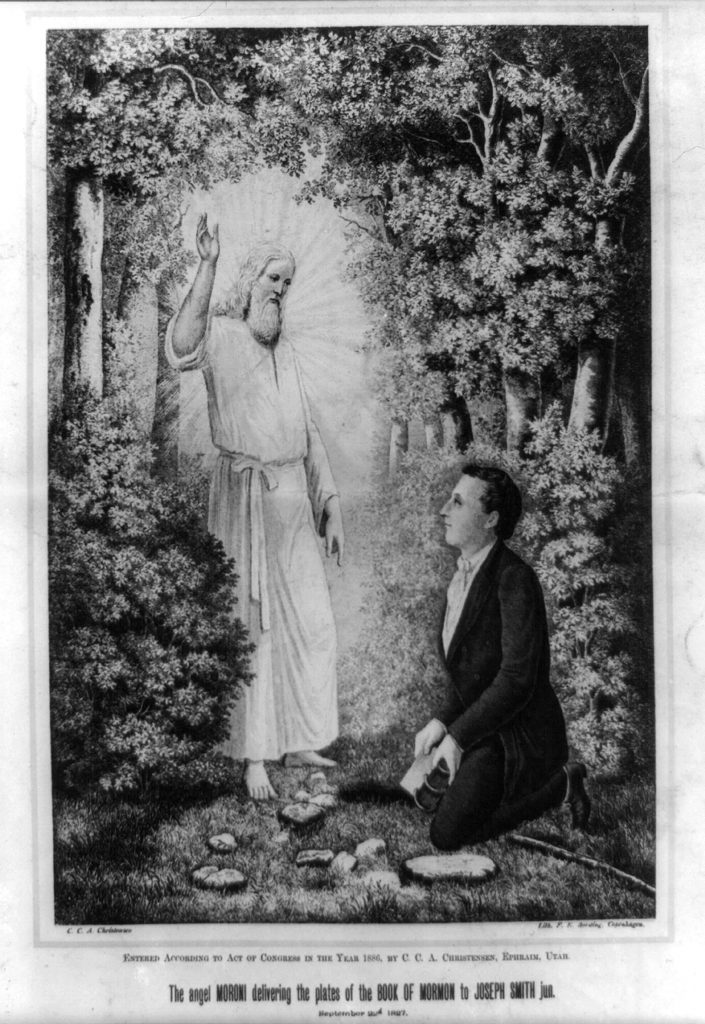Who was Moroni

Who was Moroni? A general, a historian, a son, a prophet,[1]The Book of Mormon. Trans. Joseph Smith, Jr. Salt Lake City, UT: The Church of Jesus Christ of Latter-day Saints, 1981, Moroni. and an angel of glory.
Moroni lived on the American Continent A.D. 385-421.
As a general, he led the last army of his people in a desperate fight for survival in a fight against an overwhelming hostile force. The inevitable loss against a force that outnumbered his thousands to one led to the destruction of his entire nation.
As a historian, he recorded the downfall of his people. This Commission was given to him by his father and handed down from generation to generation for over a thousand years.
As a son, he watched his father lead their people as the war began. He watched his father fight the same fight that would become his responsibility. He watched as his father fell, a victim of wounds from earlier battles.
As a prophet, he wandered alone through the ruins of what had formerly been a great nation, pursued by the Lamanites, those who had destroyed his friends, family, and nation. He hid and watched over the records of his people. In his efforts to continue and complete his Father’s work, he compiled and annotated his people’s records, helping to condene them down to a single book. Returning to the hidden records periodically to add more information,[2]The Book of Mormon, Mormon 8.4; Moroni 1.1 he would ultimately add ten chapters of his own. To supplement his words, he also included some of the teachings of his father.[3]The Book of Mormon, Moroni 1.4; Moroni 10.1 He abridged in the twenty-four gold plates of the Jaredite people, an older and larger nation than his, which had suffered a similar fate.[4]The Book of Mormon, Ether 1.1-2
All this he did, not for his own people, now gone, but for us – for future generations that would need the records he protected. He would hide the record away, under direction from the Lord. He persevered in the knowledge that his struggles had purpose.
Even until the end of his writings, he continually testified of Jesus Christ.[5]The Book of Mormon, Mormon 9.5-6 In his final farewell message, he indicated that he would soon “rest in the paradise of God.” He then ended with his testimony and nothing more is heard from him in life. [6]The Book of Mormon, Moroni 10.34
As an angel, he would deliver the news of the ancient record to Joseph Smith Jr.. The ancient record, partially written by himself, containing the fullness of the gospel of Jesus Christ. According to the Lord, Moroni is the Angel John foresaw restoring the fullness of the Gospel in Revelation 14:6-7[7]The Doctrine and Covenants of The Church of Jesus Christ of Latter-day Saints. Salt Lake City, UT: The Church of Jesus Christ of Latter-day Saints, 1981. Section 133.36-37 :
As the Salt Lake Temple neared completion, the leaders of the Church looked for something to finish off the tallest spire. An Angel weather vane had been used on Nauvoo, and it was determined that this temple should also be finished with an angel.
Wilford Woodruff commissioned Cyrus Dallin to design a statue for the pinnacle of the Salt Lake Temple. This new statue was placed so that it faced visitors approaching the front of the temple. This placement has come in the minds of many to symbolize the future coming of the Savior as described in Mathew 24:30-31:
“And then shall appear the sign of the Son of man in heaven: and then shall all the tribes of the earth mourn, and they shall see the Son of man coming in the clouds of heaven with power and great glory. And he shall send his angels with a great sound of a trumpet, and they shall gather together his elect from the four winds, from one end of heaven to the other.”
As the angel that brought the plates to Joseph Smith and consequently the restored gospel to the world, is it any wonder that Moroni would eventually become a symbol for temples belonging to the Church?
As a symbol, the Angel Moroni statue now represents many things to the members of the Church. As Moroni, he is one of the primary agents of the restoration. With the trumpet, he proclaims the restoration of the Gospel to all the world. His proclamation of the Savior’s return is symbolized by his eastward orientation. His angelic nature is a reminder of the importance of man’s contact with divine beings. His presence on many temples in many lands reminds of the universal nature of the gospel. To some, even his gilding is a reminder of the Gold Plates from which the Book of Mormon was translated.
-Thomas S. Monson [8]“Angel Moroni Statue Placed on Spire of Washington Temple.” Ensign, July 1973.
“The Angel Moroni statue, which appears on the top of several of our temples, is a reminder to us that God is concerned for all his people throughout the world and communicates with them wherever they may be
Book Navigation
References
| ↑1 | The Book of Mormon. Trans. Joseph Smith, Jr. Salt Lake City, UT: The Church of Jesus Christ of Latter-day Saints, 1981, Moroni. |
|---|---|
| ↑2 | The Book of Mormon, Mormon 8.4; Moroni 1.1 |
| ↑3 | The Book of Mormon, Moroni 1.4; Moroni 10.1 |
| ↑4 | The Book of Mormon, Ether 1.1-2 |
| ↑5 | The Book of Mormon, Mormon 9.5-6 |
| ↑6 | The Book of Mormon, Moroni 10.34 |
| ↑7 | The Doctrine and Covenants of The Church of Jesus Christ of Latter-day Saints. Salt Lake City, UT: The Church of Jesus Christ of Latter-day Saints, 1981. Section 133.36-37 |
| ↑8 | “Angel Moroni Statue Placed on Spire of Washington Temple.” Ensign, July 1973. |
Contents
